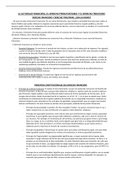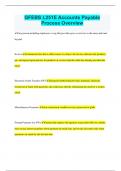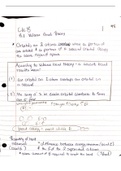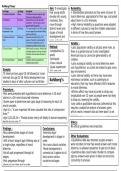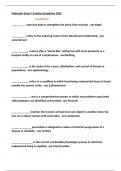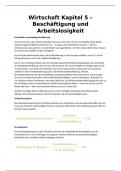Samenvatting blok 1.4
Communication in the body
The body uses three systems for communication:
1) The nervous system
2) The endocrine system (hormonal system)
1. The nervous system
1. Central nervous system (CNS)
2. Peripheral nervous system (PNS)
1. Central nervous system (CNS)
Brain
Spinal cord (does it communicate with
all the sense organs -> all about
except the ones in your brain)
2. Peripheral nervous system (PNS)
Connects CNS to the rest of the body
2 parts
Autonomic nervous system
Somatic nervous system
Autonomic nervous system
o Unconsious processes/control of the body -> heart rate, sweating, breathing
o Regulates the body’s internal environment (homeostatis)
o 2 parts
Sympathetic nervous system (fight-or-flight)
Stimulates arousal
Mobilizes energy
Parasympathetic nervous system (rest-and-digest)
Inhibits arousal
Stimulates relaxation
Conserves energy
Sexual arousal
Somatic nervous system
o Conscious processes/voluntary control of the body -> raising hand when having a question
o Regulates interaction with the external environment
o Conveying messages from senses -> CNS -> muscles
,Het zenuwstelsel is driedimensionaal en heeft drie assen:
Zie appendix 2
- Anterior-posterior: anterior verwijst richting de neus en posterior richting de staart
- Dorsaal – ventraal: dorsaal verwijst naar richting de oppervlakte van de achterkant van het
lichaam of de top van het hoofd en ventraal verwijst naar de oppervlakte van de borst of de
bodem van het hoofd
- Mediaal-lateraal: mediaal verwijst naar de middenlijn van het lichaam en lateraal verwijst
naar weg van de middenlijn van het lichaam
Bescherming centrale nervous system (dus het brein en spinal cord)
Meninges (hersenvliezen)
Dura mater: buitenste hersenvlies
Arachnoid membrane: middelste hersenvlies (spinnenweb)
Subarachnoid space: onder bovenstaande membraan, liggen grote bloedvloeten en
bevindt ook cerebrospinal fluid
Cerebrospinal fluid: vult subarachnoid space -> centrale kanaal van de ruggenwervel en
de cerebral ventricles van het brein
Pia mater: zachte hersenvlies dun en zit vastgeplakt aan het brein
Bloed-brein barrière -> rondom en in het brein bevatten de bloedvaten een extreme dichtheid ->
hierdoor kunnen bepaalde stoffen (vooral geen grote moleculen) niet bij het brein komen.
Binnen het zenuwstelsel zijn er twee type cellen te vinden:
1) Neuronen
2) Gliacellen
Neuronen
Cellen die gespecialiseerd zijn in het ontvangen, geleiden en doorsturen van info van en
naar andere cellen
Dendriet: ontvangt impulsen en geeft het door aan de axon
Cel kern (soma): heeft alle genetische info -> DNA
Myelin: electronen worden doorgeven van myeline naar myeline, laagje bovenop axon,
versneld de overdracht
Axon: stuk waar signalen doorheen gaan, heel lang, stuurt info door van het cellichaam af
Buttons: uiteindes van axon, stuurt signalen door naar andere cellen
Knoop (nodes) van Ranvier: gaten tussen myelin
Synaps: gat tussen neuronen, punt waar neuronen info doorgeven aan elkaar
Presynaptische receptoren: info van andere neuronen wordt opgevangen
,Types of neuronen:
o Sensory neurons (afferent)
-> from senses to brain
-> dichtbij zintuigen
-> smells, sounds
-> gespecialiseerd voor een specifiek soort
stimulatie
o Motor neurons (efferent)
-> from brain to muscles
o Interneurons/schakelneuronen
-> messages between neurons
Afferent neurons vs efferent neurons
o Afferent: brings info into a structure (sensory neurons) (Arrive)
o Efferent: send info away from a structure, heeft “effect” op buitenwereld (motor
neurons) (Exit)
Glai cellen
o evenveel als neuronen, helpen bij isolatie, houden neuronen op hun plek, vormen myeline
rond zenuwcellen, spelen rol bij de homeostase en hebben beschermende rol
o Glan cellen: kunnen ervoor zorgen dat het axon weer teruggroeit
Reflex arc:
- Kort neuronenpad
- Snelle spierbewegingen die komen door onverwachte externe stimuli
- Signaal van somnatic receptors in de huid -> periferal nervous system -> spinal cord ->
synaptic transmission -> motor neurons -> signals to muscles
- Slower compared to an axon
, Binnenin het neuron
Good to know:
Membraan potentiaal: verschil in elektrische lading binnen en buiten het neuron, komt door verschil van hoeveelheden in ionen
All-or-nothing respons: of wel een actiepotentiaal of niet (niet minder sterk of sterker) (in axon)
Rate law: meer actiepotentialen, intensiteit stimulus groter doordat er veel signalen achter elkaar zijn
Stap 1: Rustpotentiaal
- -70mV
- Geen verstoringen en behoudt het membraan een elektrische gradiënt: gepolariseerd
- Unequal distribution: meer kalium in de neuron/meer natrium buiten neuron
- Membraan = selectief permeabel -> sommige dingen kunnen er wel door andere niet
Ionkanalen in neuronmembraan voor Na+ is dicht, dus kan de cel NIET in, k+ kanalen
staan klein beetje open, dus kalium stroomt in minimale mate naar buiten.
- Boodschappen in een neuron komen voort uit een verstoring van het rustpotentiaal
- Bereidt het neuron voor om snel te kunnen reageren
unequal distribution veroorzaakt door:
natrium en kalium pomp: (om gradiënt die wordt verstoort door de lekkende
ionenkanalen in stand te houden) 3 natrium steeds uit de cel en 2 kalium in
neuron, zorgt voor toename van beide concentraties rond het membraan ->
(actief transport; is tegen het ‘normale’ in)
elektrostatische druk: binnenkant neuron is negatief geladen (door minder
kalium), natrium buiten het neuron is positief geladen > tegenpolen, natrium
wordt neuron ingetrokken.
Kalium is ook positief> dus deze druk houdt kalium in neuron
concentratiegradiënt: natrium naar binnen (want natrium is meer buiten, dus
gaat waarschijnlijk eerder naar binnen) kalium naar buiten (want meer in het
neuron dan buiten)
Stap 2: Actie potentiaal Depolarisatie: gebeurt met het ontvangende membraan op
moment van het binden van een neurotransmitter aan een
- -55 mV tm + 30 mV postsynaptische neuron. Rustpotentiaal wordt verkleind. (bv
- In axon, nodes van Ranvier en axonheuvel van -70 mV naar -65mV)
Postsynaptische depolarisaties = excitatory
Stap 2a: postsynaptic potentials (EPSPs) -> kans dat
neuron vuurt groot
- Activatie bereikt bepaalde grens (threshold
of excitation) door EPSPs bij -55 mV Hyperpolarisatie: kan binding tot gevolg hebben. Vergroting
- Na+ kanalen openen en Na+ komt de neuron van rustpotentiaal (bv van -70 mV naar -75mV)
dus binnen -> depolarisatie (neuron plus Postsynaptische hyperpolarisaties= Inhibitory
geladen door hoge gehalte k+ en Na+, buiten postsynaptic potentials (IPSPs) -> kans dat
wordt negatief geladen) neuron vuurt klein
Veroorzaakt door electrostatic Axon initial segment: aansluitend gedeelte van de axon, waar
pressure & pressure from actiepotentialen worden ontwikkeld
concentratie gradient
Communication in the body
The body uses three systems for communication:
1) The nervous system
2) The endocrine system (hormonal system)
1. The nervous system
1. Central nervous system (CNS)
2. Peripheral nervous system (PNS)
1. Central nervous system (CNS)
Brain
Spinal cord (does it communicate with
all the sense organs -> all about
except the ones in your brain)
2. Peripheral nervous system (PNS)
Connects CNS to the rest of the body
2 parts
Autonomic nervous system
Somatic nervous system
Autonomic nervous system
o Unconsious processes/control of the body -> heart rate, sweating, breathing
o Regulates the body’s internal environment (homeostatis)
o 2 parts
Sympathetic nervous system (fight-or-flight)
Stimulates arousal
Mobilizes energy
Parasympathetic nervous system (rest-and-digest)
Inhibits arousal
Stimulates relaxation
Conserves energy
Sexual arousal
Somatic nervous system
o Conscious processes/voluntary control of the body -> raising hand when having a question
o Regulates interaction with the external environment
o Conveying messages from senses -> CNS -> muscles
,Het zenuwstelsel is driedimensionaal en heeft drie assen:
Zie appendix 2
- Anterior-posterior: anterior verwijst richting de neus en posterior richting de staart
- Dorsaal – ventraal: dorsaal verwijst naar richting de oppervlakte van de achterkant van het
lichaam of de top van het hoofd en ventraal verwijst naar de oppervlakte van de borst of de
bodem van het hoofd
- Mediaal-lateraal: mediaal verwijst naar de middenlijn van het lichaam en lateraal verwijst
naar weg van de middenlijn van het lichaam
Bescherming centrale nervous system (dus het brein en spinal cord)
Meninges (hersenvliezen)
Dura mater: buitenste hersenvlies
Arachnoid membrane: middelste hersenvlies (spinnenweb)
Subarachnoid space: onder bovenstaande membraan, liggen grote bloedvloeten en
bevindt ook cerebrospinal fluid
Cerebrospinal fluid: vult subarachnoid space -> centrale kanaal van de ruggenwervel en
de cerebral ventricles van het brein
Pia mater: zachte hersenvlies dun en zit vastgeplakt aan het brein
Bloed-brein barrière -> rondom en in het brein bevatten de bloedvaten een extreme dichtheid ->
hierdoor kunnen bepaalde stoffen (vooral geen grote moleculen) niet bij het brein komen.
Binnen het zenuwstelsel zijn er twee type cellen te vinden:
1) Neuronen
2) Gliacellen
Neuronen
Cellen die gespecialiseerd zijn in het ontvangen, geleiden en doorsturen van info van en
naar andere cellen
Dendriet: ontvangt impulsen en geeft het door aan de axon
Cel kern (soma): heeft alle genetische info -> DNA
Myelin: electronen worden doorgeven van myeline naar myeline, laagje bovenop axon,
versneld de overdracht
Axon: stuk waar signalen doorheen gaan, heel lang, stuurt info door van het cellichaam af
Buttons: uiteindes van axon, stuurt signalen door naar andere cellen
Knoop (nodes) van Ranvier: gaten tussen myelin
Synaps: gat tussen neuronen, punt waar neuronen info doorgeven aan elkaar
Presynaptische receptoren: info van andere neuronen wordt opgevangen
,Types of neuronen:
o Sensory neurons (afferent)
-> from senses to brain
-> dichtbij zintuigen
-> smells, sounds
-> gespecialiseerd voor een specifiek soort
stimulatie
o Motor neurons (efferent)
-> from brain to muscles
o Interneurons/schakelneuronen
-> messages between neurons
Afferent neurons vs efferent neurons
o Afferent: brings info into a structure (sensory neurons) (Arrive)
o Efferent: send info away from a structure, heeft “effect” op buitenwereld (motor
neurons) (Exit)
Glai cellen
o evenveel als neuronen, helpen bij isolatie, houden neuronen op hun plek, vormen myeline
rond zenuwcellen, spelen rol bij de homeostase en hebben beschermende rol
o Glan cellen: kunnen ervoor zorgen dat het axon weer teruggroeit
Reflex arc:
- Kort neuronenpad
- Snelle spierbewegingen die komen door onverwachte externe stimuli
- Signaal van somnatic receptors in de huid -> periferal nervous system -> spinal cord ->
synaptic transmission -> motor neurons -> signals to muscles
- Slower compared to an axon
, Binnenin het neuron
Good to know:
Membraan potentiaal: verschil in elektrische lading binnen en buiten het neuron, komt door verschil van hoeveelheden in ionen
All-or-nothing respons: of wel een actiepotentiaal of niet (niet minder sterk of sterker) (in axon)
Rate law: meer actiepotentialen, intensiteit stimulus groter doordat er veel signalen achter elkaar zijn
Stap 1: Rustpotentiaal
- -70mV
- Geen verstoringen en behoudt het membraan een elektrische gradiënt: gepolariseerd
- Unequal distribution: meer kalium in de neuron/meer natrium buiten neuron
- Membraan = selectief permeabel -> sommige dingen kunnen er wel door andere niet
Ionkanalen in neuronmembraan voor Na+ is dicht, dus kan de cel NIET in, k+ kanalen
staan klein beetje open, dus kalium stroomt in minimale mate naar buiten.
- Boodschappen in een neuron komen voort uit een verstoring van het rustpotentiaal
- Bereidt het neuron voor om snel te kunnen reageren
unequal distribution veroorzaakt door:
natrium en kalium pomp: (om gradiënt die wordt verstoort door de lekkende
ionenkanalen in stand te houden) 3 natrium steeds uit de cel en 2 kalium in
neuron, zorgt voor toename van beide concentraties rond het membraan ->
(actief transport; is tegen het ‘normale’ in)
elektrostatische druk: binnenkant neuron is negatief geladen (door minder
kalium), natrium buiten het neuron is positief geladen > tegenpolen, natrium
wordt neuron ingetrokken.
Kalium is ook positief> dus deze druk houdt kalium in neuron
concentratiegradiënt: natrium naar binnen (want natrium is meer buiten, dus
gaat waarschijnlijk eerder naar binnen) kalium naar buiten (want meer in het
neuron dan buiten)
Stap 2: Actie potentiaal Depolarisatie: gebeurt met het ontvangende membraan op
moment van het binden van een neurotransmitter aan een
- -55 mV tm + 30 mV postsynaptische neuron. Rustpotentiaal wordt verkleind. (bv
- In axon, nodes van Ranvier en axonheuvel van -70 mV naar -65mV)
Postsynaptische depolarisaties = excitatory
Stap 2a: postsynaptic potentials (EPSPs) -> kans dat
neuron vuurt groot
- Activatie bereikt bepaalde grens (threshold
of excitation) door EPSPs bij -55 mV Hyperpolarisatie: kan binding tot gevolg hebben. Vergroting
- Na+ kanalen openen en Na+ komt de neuron van rustpotentiaal (bv van -70 mV naar -75mV)
dus binnen -> depolarisatie (neuron plus Postsynaptische hyperpolarisaties= Inhibitory
geladen door hoge gehalte k+ en Na+, buiten postsynaptic potentials (IPSPs) -> kans dat
wordt negatief geladen) neuron vuurt klein
Veroorzaakt door electrostatic Axon initial segment: aansluitend gedeelte van de axon, waar
pressure & pressure from actiepotentialen worden ontwikkeld
concentratie gradient

